Python 官方文档:入门教程 => 点击学习
目录本篇内容:功能场景点: ① pom引入核心依赖 ② yml加上配置项③ 创建Socket配置加载类 MySocketConfig.java④创建消息
后端 + 前端简单html页面
1. 群发,所有人都能收到
2. 局部群发,部分人群都能收到
3. 单点推送, 指定某个人的页面
惯例,先看看本次实战示例项目结构:
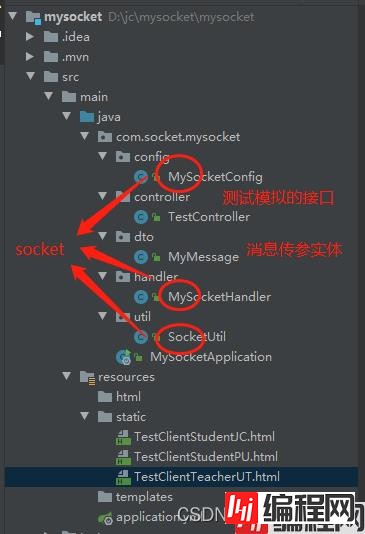
可以看到内容不多,也就是说,SpringBoot 整合socket, 跟着我学,轻轻松松。
古有曹植七步成诗,如今,咱们也是 7步学会整合socket!
不多说,开始:
<dependencies>
<dependency>
<groupId>com.alibaba</groupId>
<artifactId>fastJSON</artifactId>
<version>1.2.75</version>
</dependency>
<dependency>
<groupId>com.corundumstudio.socketio</groupId>
<artifactId>Netty-socketio</artifactId>
<version>1.7.7</version>
</dependency>
<dependency>
<groupId>org.springframework.boot</groupId>
<artifactId>spring-boot-starter-WEB</artifactId>
</dependency>
<dependency>
<groupId>org.springframework.boot</groupId>
<artifactId>spring-boot-starter-test</artifactId>
<scope>test</scope>
</dependency>
</dependencies>server:
port: 8089
socketio:
host: localhost
port: 8503
maxFramePayloadLength: 1048576
maxHttpContentLength: 1048576
bossCount: 1
workCount: 100
allowCustomRequests: true
upgradeTimeout: 10000
pingTimeout: 60000
pingInterval: 25000import com.corundumstudio.socketio.SocketConfig;
import com.corundumstudio.socketio.SocketiOServer;
import com.corundumstudio.socketio.annotation.SpringAnnotationScanner;
import org.springframework.beans.factory.annotation.Value;
import org.springframework.context.annotation.Bean;
import org.springframework.context.annotation.Configuration;
@Configuration
public class MySocketConfig{
@Value("${socketio.host}")
private String host;
@Value("${socketio.port}")
private Integer port;
@Value("${socketio.bossCount}")
private int bossCount;
@Value("${socketio.workCount}")
private int workCount;
@Value("${socketio.allowCustomRequests}")
private boolean allowCustomRequests;
@Value("${socketio.upgradeTimeout}")
private int upgradeTimeout;
@Value("${socketio.pingTimeout}")
private int pingTimeout;
@Value("${socketio.pingInterval}")
private int pingInterval;
@Bean
public SocketIOServer socketIOServer() {
SocketConfig socketConfig = new SocketConfig();
socketConfig.settcpnodelay(true);
socketConfig.setSoLinger(0);
com.corundumstudio.socketio.Configuration config = new com.corundumstudio.socketio.Configuration();
buildSocketConfig(socketConfig, config);
return new SocketIOServer(config);
}
@Bean
public SpringAnnotationScanner springAnnotationScanner() {
return new SpringAnnotationScanner(socketIOServer());
}
private void buildSocketConfig(SocketConfig socketConfig, com.corundumstudio.socketio.Configuration config) {
config.setSocketConfig(socketConfig);
config.setHostname(host);
config.setPort(port);
config.setBossThreads(bossCount);
config.setWorkerThreads(workCount);
config.setAllowCustomRequests(allowCustomRequests);
config.setUpgradeTimeout(upgradeTimeout);
config.setPingTimeout(pingTimeout);
config.setPingInterval(pingInterval);
}
}
public class MyMessage {
private String type;
private String content;
private String from;
private String to;
private String channel;
public String getType() {
return type;
}
public void setType(String type) {
this.type = type;
}
public String getContent() {
return content;
}
public void setContent(String content) {
this.content = content;
}
public String getFrom() {
return from;
}
public void setFrom(String from) {
this.from = from;
}
public String getTo() {
return to;
}
public void setTo(String to) {
this.to = to;
}
public String getChannel() {
return channel;
}
public void setChannel(String channel) {
this.channel = channel;
}
}代码简析:
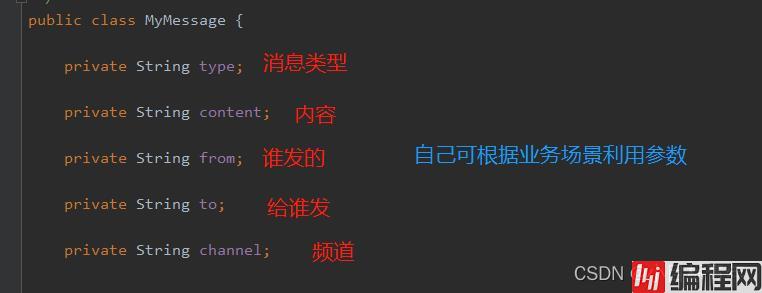
MySocketHandler.java
import com.corundumstudio.socketio.Socketioclient;
import com.corundumstudio.socketio.SocketIOServer;
import com.corundumstudio.socketio.annotation.OnConnect;
import com.corundumstudio.socketio.annotation.OnDisconnect;
import com.socket.mysocket.util.SocketUtil;
import org.springframework.beans.factory.annotation.Autowired;
import javax.annotation.PostConstruct;
import javax.annotation.PreDestroy;
import org.slf4j.Logger;
import org.slf4j.LoggerFactory;
import org.springframework.stereotype.Component;
@Component
public class MySocketHandler {
private final Logger log = LoggerFactory.getLogger(this.getClass());
@Autowired
private SocketIOServer socketIoServer;
@PostConstruct
private void start(){
try {
socketIoServer.start();
}catch (Exception e){
e.printStackTrace();
}
}
@PreDestroy
private void destroy(){
try {
socketIoServer.stop();
}catch (Exception e){
e.printStackTrace();
}
}
@OnConnect
public void connect(SocketIOClient client) {
String userFlag = client.getHandshakeData().getSingleUrlParam("userFlag");
SocketUtil.connectMap.put(userFlag, client);
log.info("客户端userFlag: "+ userFlag+ "已连接");
}
@OnDisconnect
public void onDisconnect(SocketIOClient client) {
String userFlag = client.getHandshakeData().getSingleUrlParam("userFlag");
log.info("客户端userFlag:" + userFlag + "断开连接");
SocketUtil.connectMap.remove(userFlag, client);
}
}代码简析:
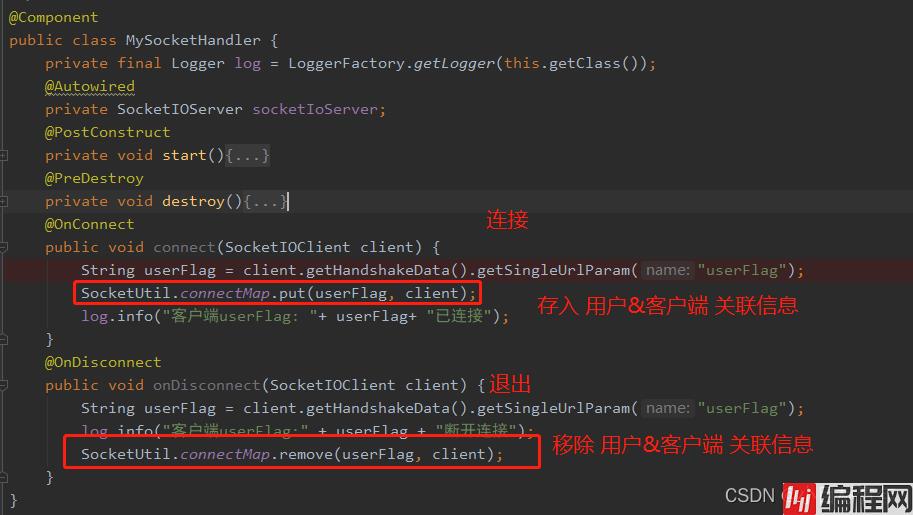
SocketUtil.java
import com.alibaba.fastjson.JSON;
import com.alibaba.fastjson.JSONObject;
import com.corundumstudio.socketio.AckRequest;
import com.corundumstudio.socketio.SocketIOClient;
import com.corundumstudio.socketio.annotation.OnEvent;
import org.slf4j.Logger;
import org.slf4j.LoggerFactory;
import org.springframework.beans.factory.annotation.Autowired;
import org.springframework.stereotype.Component;
import org.springframework.util.StringUtils;
import java.util.Map;
import java.util.Objects;
import java.util.concurrent.ConcurrentHashMap;
import java.util.concurrent.ConcurrentMap;
@Component
public class SocketUtil {
private final Logger log = LoggerFactory.getLogger(this.getClass());
//暂且把用户&客户端信息存在缓存
public static ConcurrentMap<String, SocketIOClient> connectMap = new ConcurrentHashMap<>();
@OnEvent(value = "CHANNEL_SYSTEM")
public void systemDataListener(String receiveMsg) {
if (!StringUtils.hasLength(receiveMsg)){
return;
}
JSONObject msGobject = (JSONObject) JSON.parse(receiveMsg);
String userFlag = String.valueOf(msgObject.get("from"));
String content = String.valueOf(msgObject.get("content"));
log.info("收到用户 : {} 推送到系统频道的一条消息 :{}",userFlag,content );
}
public void sendToAll(Map<String, Object> msg,String sendChannel) {
if (connectMap.isEmpty()){
return;
}
//给在这个频道的每个客户端发消息
for (Map.Entry<String, SocketIOClient> entry : connectMap.entrySet()) {
entry.getValue().sendEvent(sendChannel, msg);
}
}
public void sendToOne(String userFlag, Map<String, Object> msg,String sendChannel) {
//拿出某个客户端信息
SocketIOClient socketClient = getSocketClient(userFlag);
if (Objects.nonNull(socketClient) ){
//单独给他发消息
socketClient.sendEvent(sendChannel,msg);
}
}
public SocketIOClient getSocketClient(String userFlag){
SocketIOClient client = null;
if (StringUtils.hasLength(userFlag) && !connectMap.isEmpty()){
for (String key : connectMap.keySet()) {
if (userFlag.equals(key)){
client = connectMap.get(key);
}
}
}
return client;
}
}代码简析:

TestController.java
import com.socket.mysocket.dto.MyMessage;
import com.socket.mysocket.util.SocketUtil;
import org.springframework.beans.factory.annotation.Autowired;
import org.springframework.web.bind.annotation.*;
import java.util.HashMap;
import java.util.Map;
@RestController
public class TestController {
public final static String SEND_TYPE_ALL = "ALL";
public final static String SEND_TYPE_ALONE = "ALONE";
@Autowired
SocketUtil socketUtil;
@PostMapping("/testSendMsg")
public String testSendMsg(@RequestBody MyMessage myMessage){
Map<String, Object> map = new HashMap<>();
map.put("msg",myMessage.getContent());
//群发
if (SEND_TYPE_ALL.equals(myMessage.getType())){
socketUtil.sendToAll( map,myMessage.getChannel());
return "success";
}
//指定单人
if (SEND_TYPE_ALONE.equals(myMessage.getType())){
socketUtil.sendToOne(myMessage.getTo(), map, myMessage.getChannel());
return "success";
}
return "fail";
}
}代码简析:
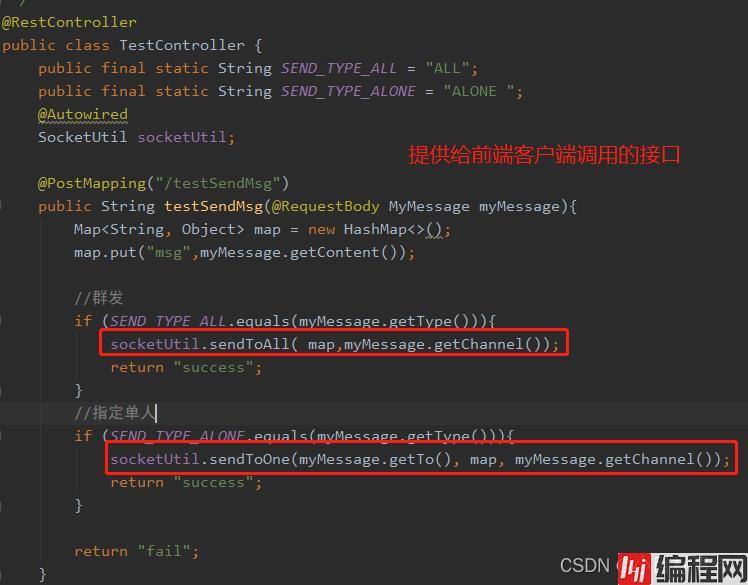
好了,7步了。一切已经就绪了。
接下来搞点前端HTML页面, 玩一玩看看效果:
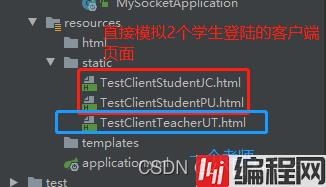
第一个页面:
TestClientStudentJC.html
<!DOCTYPE html>
<html>
<head>
<meta http-equiv="Content-Type" content="text/html; charset=utf-8"/>
<title>我要连SOCKET</title>
<base>
<script src="https://cdn.bootCSS.com/Jquery/3.4.0/jquery.min.js"></script>
<script src="https://cdn.bootcss.com/socket.io/2.2.0/socket.io.js"></script>
<style>
body {
padding: 20px;
}
#console {
height: 450px;
overflow: auto;
}
.msg-color {
color: green;
}
</style>
</head>
<body>
<div id="console" class="well"></div>
<div id="conversationDiv">
<labal>给系统推消息</labal>
<input type="text" id="content"/>
<button id="btnSendToSystem" onclick="sendSys();">发送</button>
</div>
</body>
<script type="text/javascript">
var socket;
connect();
function connect() {
var userFlag = 'user_JC';
var opts = {
query: 'userFlag=' + userFlag
};
socket = io.connect('http://localhost:8503', opts);
socket.on('connect', function () {
console.log("连接成功");
output('当前用户是:' + userFlag );
output('<span class="msg-color">连接成功了。</span>');
});
socket.on('disconnect', function () {
output('<span class="msg-color">下线了。 </span>');
});
socket.on('CHANNEL_STUDENT', function (data) {
let msg= JSON.stringify(data)
output('收到学生频道消息了:' + msg );
console.log(data);
});
socket.on('CHANNEL_SYSTEM', function (data) {
let msg= JSON.stringify(data)
output('收到系统全局消息了:' + msg );
console.log(data);
});
}
function sendSys() {
console.log('发送消息给服务端');
var content = document.getElementById('content').value;
socket.emit('CHANNEL_SYSTEM',JSON.stringify({
'content': content,
'from': 'user_JC'
}));
}
function output(message) {
var element = $("<div>" + message + "</div>");
$('#console').prepend(element);
}
</script>
</html>代码简析:
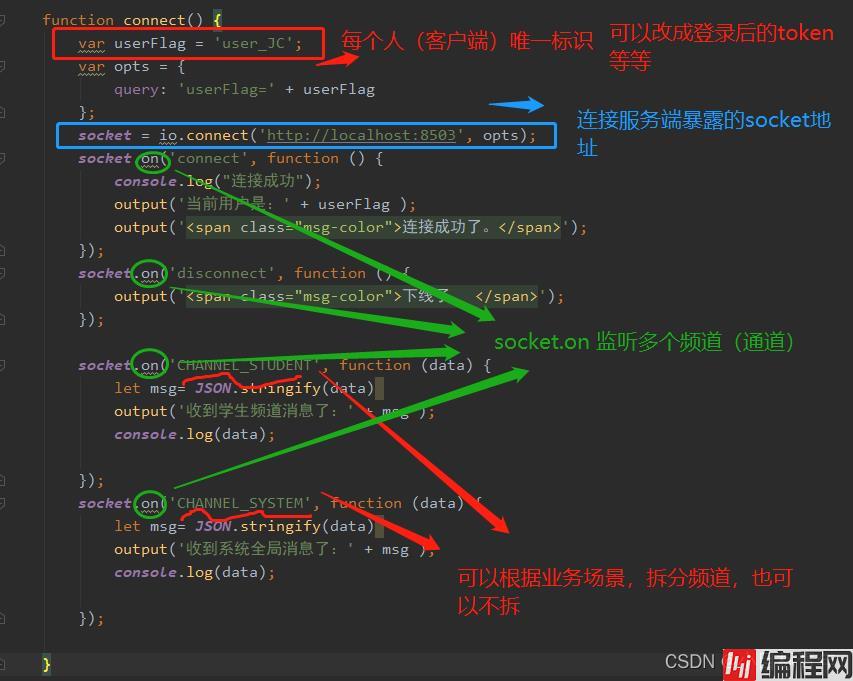
第二个页面,跟第一个基本一样,改一下用户唯一标识:
TestClientStudentPU.html
<!DOCTYPE html>
<html>
<head>
<meta http-equiv="Content-Type" content="text/html; charset=utf-8"/>
<title>我要连SOCKET</title>
<base>
<script src="https://cdn.bootcss.com/jquery/3.4.0/jquery.min.js"></script>
<script src="https://cdn.bootcss.com/socket.io/2.2.0/socket.io.js"></script>
<style>
body {
padding: 20px;
}
#console {
height: 450px;
overflow: auto;
}
.msg-color {
color: green;
}
</style>
</head>
<body>
<div id="console" class="well"></div>
<div id="conversationDiv">
<labal>给系统推消息</labal>
<input type="text" id="content"/>
<button id="btnSendToSystem" onclick="sendSys();">发送</button>
</div>
</body>
<script type="text/javascript">
var socket;
connect();
function connect() {
var userFlag = 'user_PU';
var opts = {
query: 'userFlag=' + userFlag
};
socket = io.connect('http://localhost:8503', opts);
socket.on('connect', function () {
console.log("连接成功");
output('当前用户是:' + userFlag );
output('<span class="msg-color">连接成功了。</span>');
});
socket.on('disconnect', function () {
output('<span class="msg-color">下线了。 </span>');
});
socket.on('CHANNEL_STUDENT', function (data) {
let msg= JSON.stringify(data)
output('收到学生频道消息了:' + msg );
console.log(data);
});
socket.on('CHANNEL_SYSTEM', function (data) {
let msg= JSON.stringify(data)
output('收到系统全局消息了:' + msg );
console.log(data);
});
}
function sendSys() {
console.log('发送消息给服务端');
var content = document.getElementById('content').value;
socket.emit('CHANNEL_SYSTEM',JSON.stringify({
'content': content,
'from': 'user_PU'
}));
}
function output(message) {
var element = $("<div>" + message + "</div>");
$('#console').prepend(element);
}
</script>
</html>OK,把项目跑起来,开始玩。
直接访问客户端页面 模拟学生 JC连接socket:
http://127.0.0.1:8089/TestClientStudentJC.html
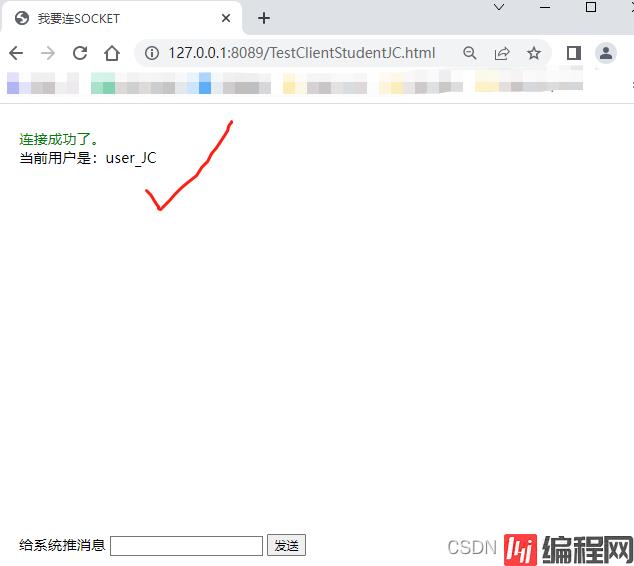
可以看到服务端有监测到:

这里监测的:

先试试客户端给系统推消息先:

可以看到服务端成功收到消息:

这种方式,其实是因为服务监听了相关的频道:

前端使用JS推到这个系统频道:

ps: 其实前端给服务端推消息,其实调用接口就可以。
OK,进入核心应用场景1:
系统给连上的客户端都推送消息
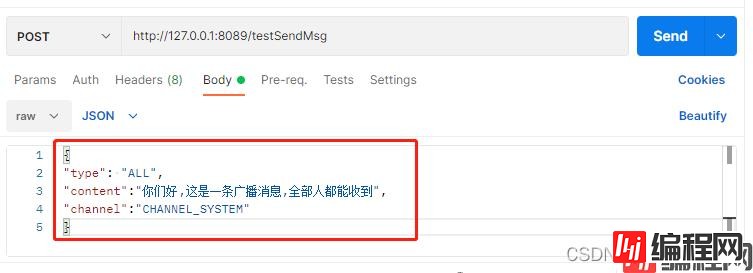
{
"type": "ALL",
"content":"你们好,这是一条广播消息,全部人都能收到",
"channel":"CHANNEL_SYSTEM"
}看看效果

其实也就是通过HTML 客户端监听主题做区分就好:
直接拉人口,升3 :
模拟2个学生,1个老师都连接上了socket
当然,老师监听的是 老师频道:

然后我们模拟推送一下消息到指定的老师频道:
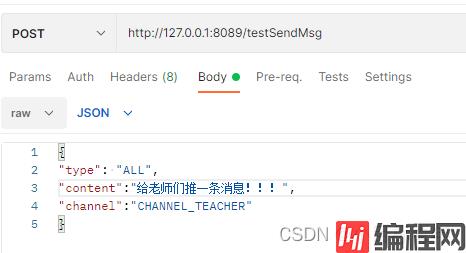
{
"type": "ALL",
"content":"给老师们推一条消息!!!",
"channel":"CHANNEL_TEACHER"
}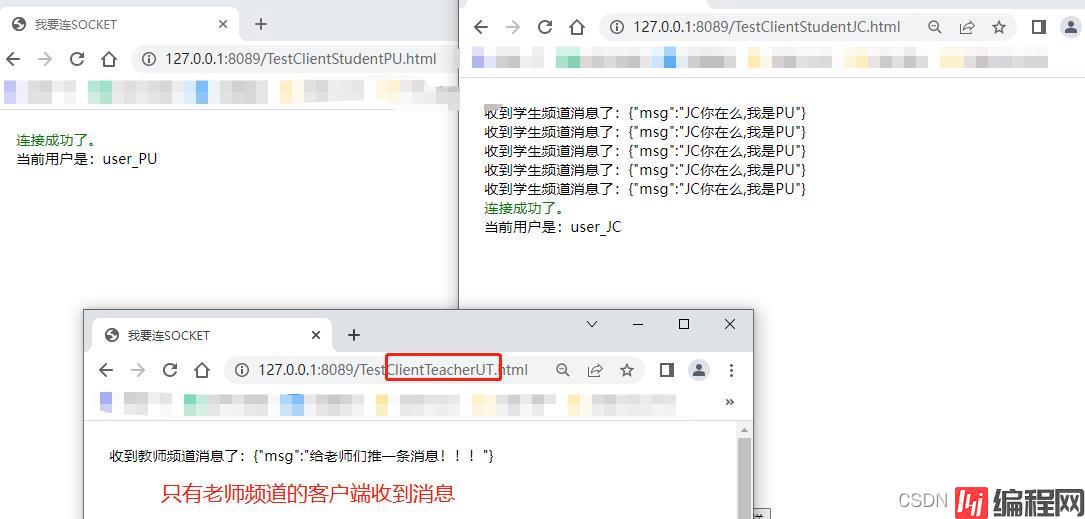
模拟 学生 PU 给 学生JC 推消息:
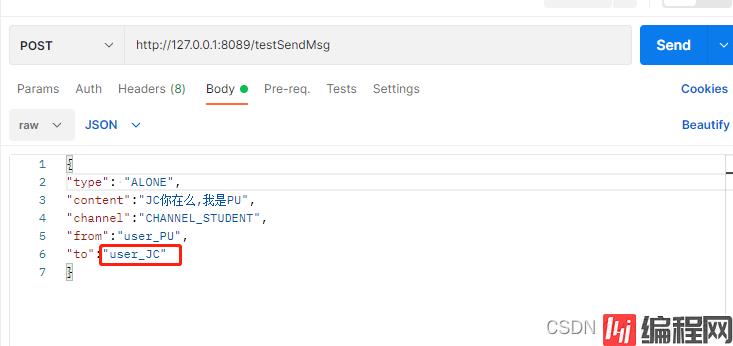
可以看到在学生频道的JC正常收到了PU的消息:
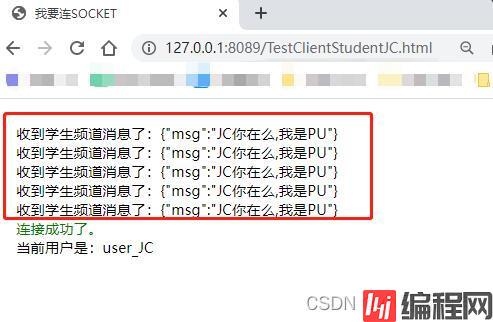
到此这篇关于Springboot整合Socket实现单点发送,广播群发,1对1,1对多实战的文章就介绍到这了,更多相关Springboot Socket实战内容请搜索编程网以前的文章或继续浏览下面的相关文章希望大家以后多多支持编程网!
--结束END--
本文标题: Springboot整合Socket实现单点发送,广播群发,1对1,1对多实战
本文链接: https://lsjlt.com/news/171487.html(转载时请注明来源链接)
有问题或投稿请发送至: 邮箱/279061341@qq.com QQ/279061341
2024-03-01
2024-03-01
2024-03-01
2024-02-29
2024-02-29
2024-02-29
2024-02-29
2024-02-29
2024-02-29
2024-02-29
回答
回答
回答
回答
回答
回答
回答
回答
回答
回答
0